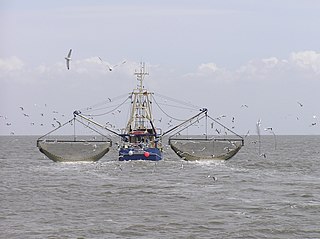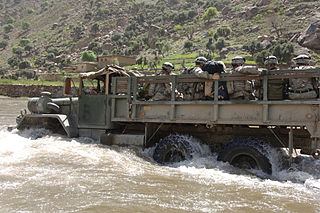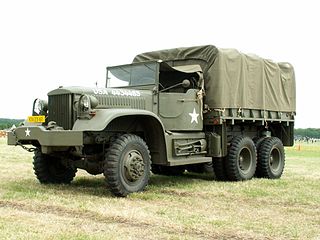
A jibe (US) or gybe (Britain) is a sailing maneuver whereby a sailing craft reaching downwind turns its stern through the wind, which then exerts its force from the opposite side of the vessel. It stands in contrast with tacking, whereby the sailing craft turns its bow through the wind.

A crane is a machine used to move materials both vertically and horizontally, utilizing a system of a boom, hoist, wire ropes or chains, and sheaves for lifting and relocating heavy objects within the swing of its boom. The device uses one or more simple machines, such as the lever and pulley, to create mechanical advantage to do its work. Cranes are commonly employed in transportation for the loading and unloading of freight, in construction for the movement of materials, and in manufacturing for the assembling of heavy equipment.

Boat building is the design and construction of boats — and their on-board systems. This includes at minimum the construction of a hull, with any necessary propulsion, mechanical, navigation, safety and other service systems as the craft requires.

A spinnaker is a sail designed specifically for sailing off the wind on courses between a reach to downwind. Spinnakers are constructed of lightweight fabric, usually nylon, and are often brightly colored. They may be designed to perform best as either a reaching or a running spinnaker, by the shaping of the panels and seams. They are attached at only three points and said to be flown.

A fishing trawler is a commercial fishing vessel designed to operate fishing trawls. Trawling is a method of fishing that involves actively dragging or pulling a trawl through the water behind one or more trawlers. Trawls are fishing nets that are pulled along the bottom of the sea or in midwater at a specified depth. A trawler may also operate two or more trawl nets simultaneously.

A guyed mast is a tall thin vertical structure that depends on guy lines for stability. The mast itself has the compressive strength to support its own weight, but does not have the shear strength to stand unsupported or bear loads. It requires guy lines to stay upright and to resist lateral (shear) forces such as wind loads. Examples include masts on sailing vessels, towers for telecommunications, meteorology, and masts on cranes, power shovels, draglines, and derricks, starting with the simple gin pole.

A guy-wire, guy-line, guy-rope, down guy, or stay, also called simply a guy, is a tensioned cable designed to add stability to a freestanding structure. They are used commonly for ship masts, radio masts, wind turbines, utility poles, and tents. A thin vertical mast supported by guy wires is called a guyed mast. Structures that support antennas are frequently of a lattice construction and are called "towers". One end of the guy is attached to the structure, and the other is anchored to the ground at some distance from the mast or tower base. The tension in the diagonal guy-wire, combined with the compression and buckling strength of the structure, allows the structure to withstand lateral loads such as wind or the weight of cantilevered structures. They are installed radially, usually at equal angles about the structure, in trios and quads. As the tower leans a bit due to the wind force, the increased guy tension is resolved into a compression force in the tower or mast and a lateral force that resists the wind load. For example, antenna masts are often held up by three guy-wires at 120° angles. Structures with predictable lateral loads, such as electrical utility poles, may require only a single guy-wire to offset the lateral pull of the electrical wires at a spot where the wires change direction.

In sailing, a boom is a spar (pole), along the of a fore and aft rigged sail, that greatly improves control of the angle and shape of the sail. The primary action of the boom is to keep the foot flatter when the sail angle is away from the centerline of the boat. The boom also serves as an attachment point for more sophisticated control lines. Because of the improved sail control it is rare to find a non-headsail without a boom, but lateen sails, for instance, are loose-footed. In some modern applications, the sail is rolled up into the boom for storage or reefing.

A fly system, or theatrical rigging system, is a system of ropes, pulleys, counterweights and related devices within a theater that enables a stage crew to fly (hoist) quickly, quietly and safely components such as curtains, lights, scenery, stage effects and, sometimes, people. Systems are typically designed to fly components between clear view of the audience and out of view, into the large space, the fly loft, above the stage.

A gin pole is a mast supported by one or more guy-wires that uses a pulley or block and tackle mounted on its upper end to lift loads. The lower end is braced or set in a shallow hole and positioned so the upper end lies above the object to be lifted. The pole is secured with three or more guys. These are manipulated to move the load laterally, with up and down controlled by the pulley or block. In tower construction, a gin pole can also be “jumped” up the completed sections of a tower to lift the higher sections into place.

A fishing vessel is a boat or ship used to catch fish and other valuable nektonic aquatic animals in the sea, lake or river. Humans have used different kinds of surface vessels in commercial, artisanal and recreational fishing.

The M39 series 5-ton 6×6 truck (G744) was a family of heavy tactical trucks built for the United States Armed Forces. The basic cargo version was designed to transport a 5-ton (4,500 kg), 14 ft (4.3 m) long load over all terrain in all weather. In on-road service the load weight was doubled.

Shear legs, also known as sheers, shears, or sheer legs, are a form of two-legged lifting device. Shear legs may be permanent, formed of a solid A-frame and supports, as commonly seen on land and the floating sheerleg, or temporary, as aboard a vessel lacking a fixed crane or derrick.

Ljungström rig is the name for the sailing rig designed by Swedish engineer Fredrik Ljungström with double main sails and rotating mast, but without boom, foresail, forestay and shroud. The early models of the Ljungström sailboat had a stern stay but this was omitted around 1945, before the model 12.

The M809 Series 5-ton 6x6 truck (G908) was a family of heavy tactical trucks built for the United States Armed Forces. The basic cargo version was designed to transport a 5-ton (4,500 kg), 14 ft (4.3 m) long load over all terrain in all weather. In on-road service the load weight was doubled. Built by AM General, they evolved into the M939 Series.

Carmila Cane Lift is a heritage-listed piece of agricultural equipment at 49 Hindles Road, Carmila, Isaac Region, Queensland, Australia. It was built between the 1920s and the 1960s. It was added to the Queensland Heritage Register on 5 February 2010.

Mount Martin Cane Lift is a heritage-listed piece of agricultural equipment at Mirani Mount Ossa Road, Mount Martin, Mackay Region, Queensland, Australia. It was built before 1939. It was added to the Queensland Heritage Register on 5 February 2010.

The Leap Cane Lift is a heritage-listed piece of agricultural equipment at Bruce Highway, The Leap, Mackay Region, Queensland, Australia. It was built before the 1960s. It was added to the Queensland Heritage Register on 5 February 2010.

The Diamond T 4-ton 6×6 truck was a heavy tactical truck built for the United States Army during World War II. Its G-number was G-509. Cargo models were designed to transport a 4-ton (3,600 kg) load over all terrain in all weather. There were also wrecker, dump, and other models. They were replaced by the M39 series 5-ton 6×6 trucks in the 1950s.

Salambáw, is a type of lift net used by indigenous fishermen in the Philippines. They are found throughout the Philippine islands but are most prevalent in large lakes like Laguna de Bay, and sheltered coastal areas like Manila Bay, Ragay Gulf, and Batan Bay. Variations of salambáw lift nets include the bintol, panak, tangkal, and the basnig. Salambáw rafts were also known as saraboa or salakab.































